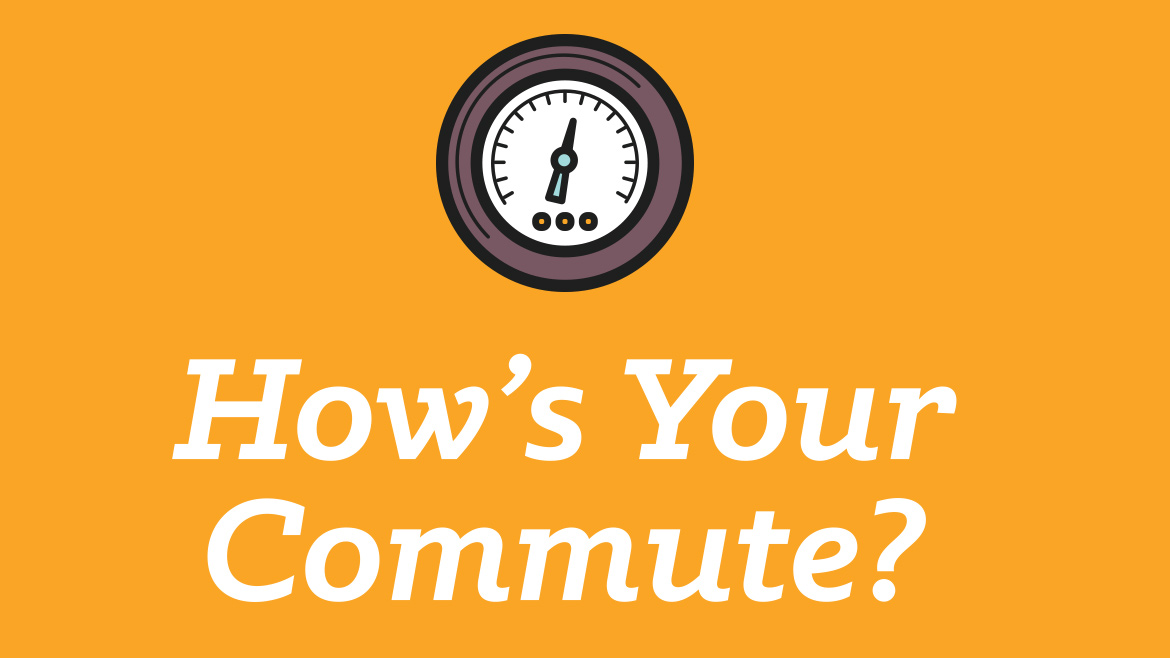The Long Drive: Commuting in (and around) Columbia

As Columbia has gotten to be a bigger city — now the fourth largest in Missouri — we’ve had to answer more big-city questions. How do we make sure we’re developing responsibly? How do we protect social equity? How do we foster a labor market that can create jobs to match all the population growth? How do I still not have cell service at my apartment? The list goes on, and it’ll only get longer as the city gets bigger.
A common refrain about Columbia on tourism websites is that we combine a small town’s vibe with a big city’s amenities. The Columbia Convention and Visitors Bureau says COMO is like “a cool neighborhood in a big city”; MU’s “About Columbia” web page says the city combines “small-town comforts, community spirit and low cost of living with big-city culture, activities, and resources.”
Columbia can still justify small town credentials — according to the latest U.S. Census numbers, we’re still about 50,000 people behind Springfield, 200,000 behind St. Louis, and 350,000 behind Kansas City, and Missouri is in the middle of the pack as far as state populations go — but the disparity between our city and the no-doubt-about-it small towns that surround us will only get harder to ignore. So, even on a Mid-Missouri scale, people looking to get away from the hubbub of the big city will do what they’ve done for the last 75 years or so. They’ll commute.
A city’s commuting force can be roughly measured by its daytime population change: the number of people who don’t live in the city, but show up during weekdays to work. The last official daytime population count for Columbia came in 2005, when the Census estimated that 22,000 people drove in for work every day, a population increase of 26 percent. Of course, that was in 2005, when Columbia had 23,000 fewer people. If we think conservatively, saying that Columbia’s daytime population rate is still 26 percent, then Columbia now brings in around 31,000 people. It’s impossible to say without definitive Census data, but that means Columbia has probably eclipsed Jefferson City as the most commuted-to city in Mid-Missouri (Jefferson City’s 2005 daytime population increase was 25,906). And so far, Columbia’s workforce population has roughly kept pace with its resident population, but bigger cities usually add jobs faster than they add residents — if the city keeps growing, its commuter population will probably start growing even faster.
All this is to say that Columbia is increasingly becoming a commuter city. The city already has the infrastructure to bring in more workers from out-of-town: we’re at the intersection of two major highways, I-70 and Highway 63, and there’s no shortage of small, quiet communities with a low cost of living within a drivable distance. Most importantly, we have the jobs. Alex Smith, a pharmacist and part owner at Flow’s Pharmacy, commutes from Boonville to his office on Keene Street every day — with typical heavy traffic (especially on the dreaded I-70/63 interchange), it takes him about 30 minutes each way. He started off at the job part-time, but when a full-time opportunity arose, he decided the commute was worth it. “It’s a larger economy over here,” he says, “and job opportunities are already pretty scarce.”
Commuting is a big-city problem that Columbians are still learning to navigate. At some point in the future, it may be harder to argue that Columbia has a small-town vibe: it’ll be harder for someone to take a job in Columbia and still be a 10-minute drive from downtown, the grocery store, their doctor, and their kid’s school. But there are fun parts of being commuter-friendly, some of which you’ll find here. And having a lot of people want to work in your city isn’t a bad problem to have.
![]()
Fourth Place, Best Place?
Last May, Columbia overtook Independence as the fourth biggest city in Missouri (and according to the commuting numbers, Independence is basically just a KC suburb anyway). That may have been bad news for small-town devotees, but the good news is that you can move to, say, Rocheport, work in Columbia, and enjoy the best of both worlds — and your commute will be relatively painless. Take a look at how the COMO commute compares to Missouri’s biggest three cities:
Columbia and Springfield data from Obrella and U.S. Census Bureau; St. Louis and Kansas City data from Associated Press, U.S. Census Bureau, and Sperling’s Best Places.
COLUMBIA
Population: 119,108
Average commute time: 16.8 minutes
Percentage of people who commute alone: 76%
Percentage of people who get to work in 29 minutes or fewer: 88%
SPRINGFIELD
Population: 166,810
Average commute time: 17.2 minutes
Percentage of people who commute alone: 80.2%
Percentage of people who get to work in 29 minutes or fewer: 88%
ST. LOUIS
Population: 315,685
Average commute time: 23.6 minutes
Percentage of people who commute alone: 83.2%
Percentage of people who get to work in 29 minutes or fewer: 62%
KANSAS CITY
Population: 475,378
Average commute time: 21.6 minutes
Percentage of people who commute alone: 83.5%
Percentage of people who get to work in 29 minutes of fewer: 74%
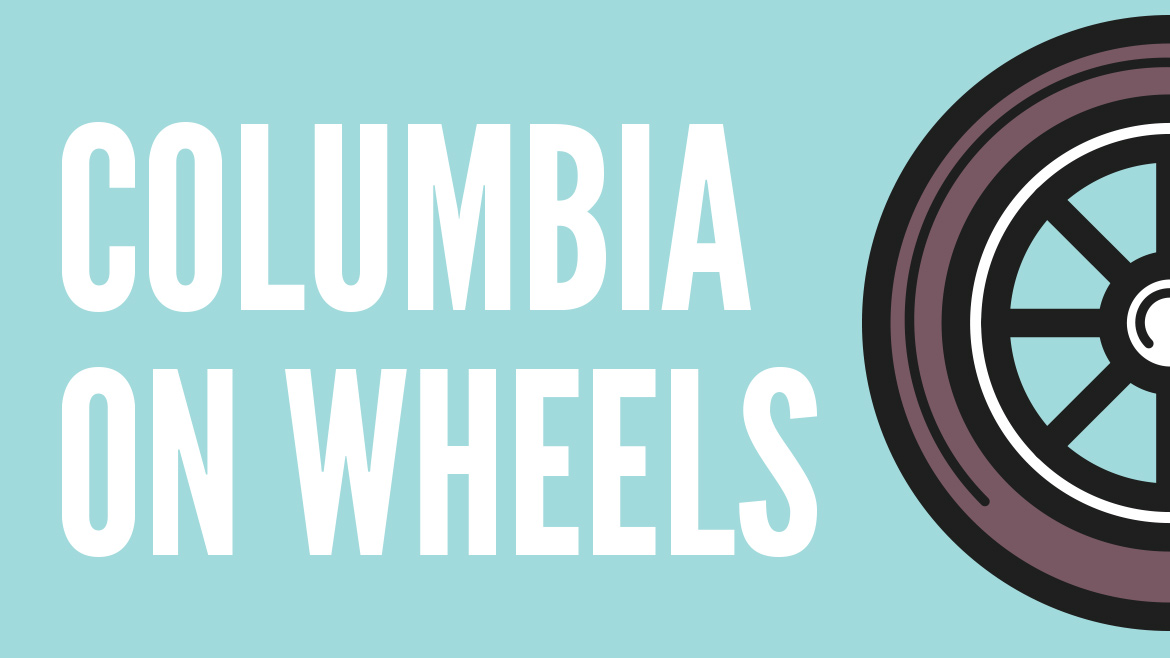
For most of its history, Columbia has been local. People lived nearby, they worked nearby, and they played nearby. We took a look at some of the turning points in Columbia’s transportation history that made us a commuter hub for Mid-Missouri.
1818-1920
Columbia is founded, becomes home to a university, and builds a community. Mid-Missouri is almost entirely agricultural. Between 1900 and 1920, Columbia’s population doubles, to a little over 10,000. Wabash Railway and MKT Lines both establish train stations in Columbia.
1920-1940
The Missouri State Highway Department is created in 1921 to create a more cohesive system of paved roads across the state. Transportation is incorporated into “A City Plan for Columbia, Missouri,” which local officials drew up in 1935, when the city’s population is around 15,000.
1940-1960
Thanks to the passage of the GI Bill, which opened up higher education to WWII veterans, Columbia’s population doubles in 20 years. MU’s expansion makes Columbia a true college town, and the city’s economic interests diversify. The Highway Department lays out a preliminary map of what an interstate highway system will look like in Missouri.
1960-1980
Lucky enough, Columbia happens to be on an almost straight line between Kansas City and St. Louis. As a result, Interstate 70 is built to run through northern Columbia. The city establishes a public transit system in 1965. The Columbia Area Transportation Study Organization, or CATSO, develops the first thoroughfare plan for Boone County in 1968.
1980-2000
Columbia continues to outpace Jefferson City in population growth, making it the largest employment center in mid-Missouri. Residential development in the city further spreads from downtown, especially to the south.
2000-2017
Another spike in enrollment at MU prompts more growth in Columbia. The city eclipses 100,000 in population and becomes the fourth largest city in the state. In December 2016, the city had a labor force of 102,404 and last year’s average unemployment rate was 3.2 percent — the lowest since 2001.
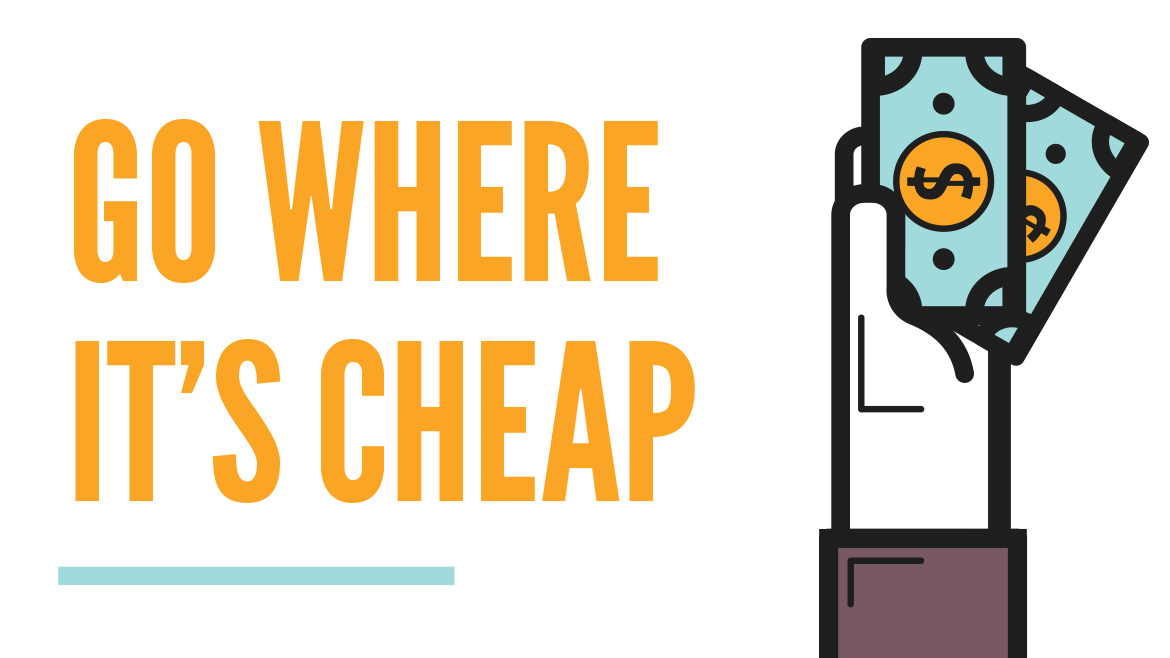
Cost-of-living factors often motivate a person to a commute — why take an apartment in the city when you can have a house in the country, right? And since we live in the city with the highest cost of living in Missouri (seriously), we decided to compare COMO with some of the commuting-distance cities around us.
Cost of Living info from Sperling’s Best Places, 2016. Drive times from Google Maps. Cost of living index is against a U.S. average of 100.
- Columbia
- Population: 119,108
- Cost of Living: 2
- Miles to Columbia: 0 (duh)
- Drive time to Columbia: 0 min. (also duh)
- Why it’s a great place to live: Mizzou football, great restaurants, trail access . . . need we say more?
- Jefferson City
- Population: 43,169
- Cost of Living: 7
- Miles to Columbia: 3
- Drive time to Columbia: 32 min.
- Why it’s a great place to live: Endless fun for history buffs. And, with all the lawmakers around, it’s a great place to be a lobbying hobbyist. (We’re joking.)
- Fulton
- Population: 12,939
- Cost of Living: 1
- Miles to Columbia:7
- Drive time to Columbia: 29 min.
- Why it’s a great place to live: You can still live in a college town! William Woods University and Westminster have you covered.
- Moberly
- Population: 13,919
- Cost of Living: 8
- Miles to Columbia: 4
- Drive time to Columbia: 36 min.
- Why it’s a great place to live: For your kids, Moberly Parks and Recreation operates a robust youth sports program.
- Boonville
- Population: 8,403
- Cost of Living: 3
- Miles to Columbia:1
- Drive time to Columbia: 32 min.
- Why it’s a great place to live:
An active downtown right next to the Missouri River? Easy appeal. And you don’t have to lose your in-town Katy Trail access.
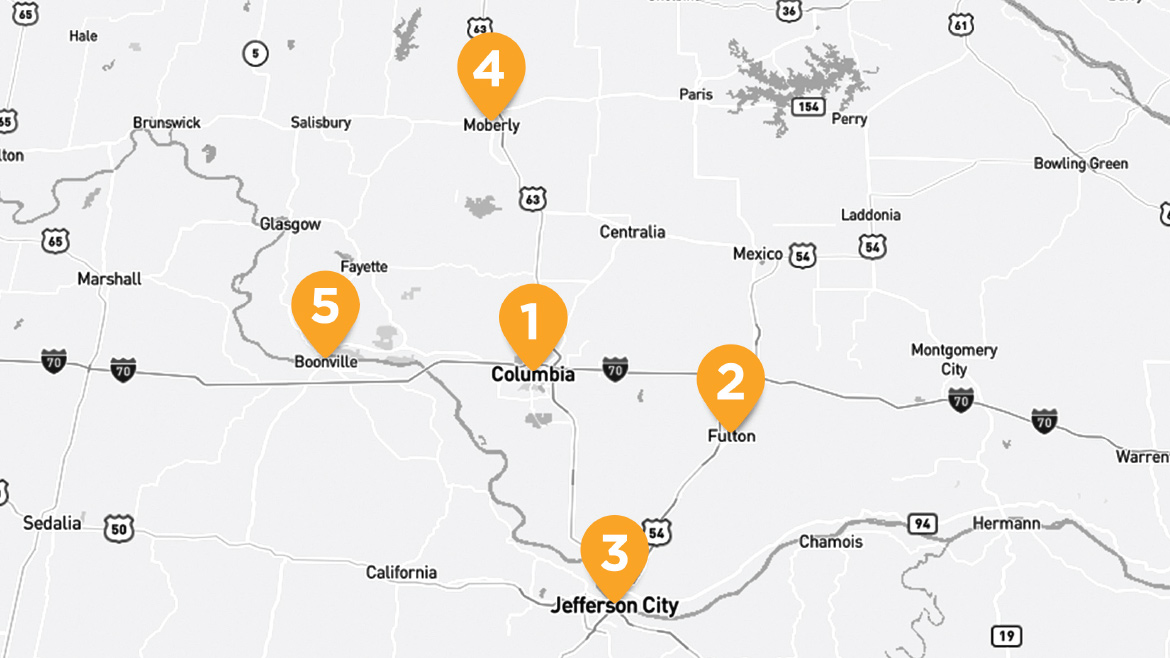
What’s the Deal with MSAs?
An MSA, or metropolitan statistical area, is essentially the government’s way of keeping tabs on how many people are working in a city. This information can be useful for economists to explain different dimensions of an area’s economy — the Columbia MSA, which includes Boone, Audrain, and Randolph counties, has different needs and labor characteristics than, say, the St. Louis MSA. A city’s MSA is used when calculating employment rates and other labor force statistics, and city leaders can use MSA information to shape local policy. And, of course, it’s all determined by commuting.
MSAs are drawn up by the federal Office of Management and Budget, and they center around “core urbanized areas.” In common parlance, that means “cities.” If an urbanized area has a population higher than 50,000, it qualifies for an MSA, which includes the city and any relevant outlying counties; under the current guidelines, 25 percent of a county’s workforce must commute to the urbanized area to qualify as part of the MSA.
A 2007 paper published in The Annals of Regional Science suggests that counties included in a MSA designation can experience short-term population and employment growth, but experience little long-term effects on income. But while MSA numbers may not have a direct effect on economic growth, they can arm policymakers with information that can affect the economy: the Department of Housing and Urban Development, for example, uses the data to evaluate Section 8 housing policy in a city. Just last May, the Missouri Hospital Association used state-level MSAs to help present the Missouri Department of Insurance with an argument against the $37 billion merger of Aetna and Humana, two national health insurers (the merger has since been blocked by a federal court).
The Columbia MSA currently holds about 222,000 people, according the U.S. Census’ 2015 population estimates. The MSA also included Howard County, population 10,182, until 2010, when the commuting levels dipped low enough that the county became unaffiliated with any MSA. But, seeing as Columbia has experienced significant population growth (about 9,000) since the 2010 census, our MSA could add a county following the 2020 census.
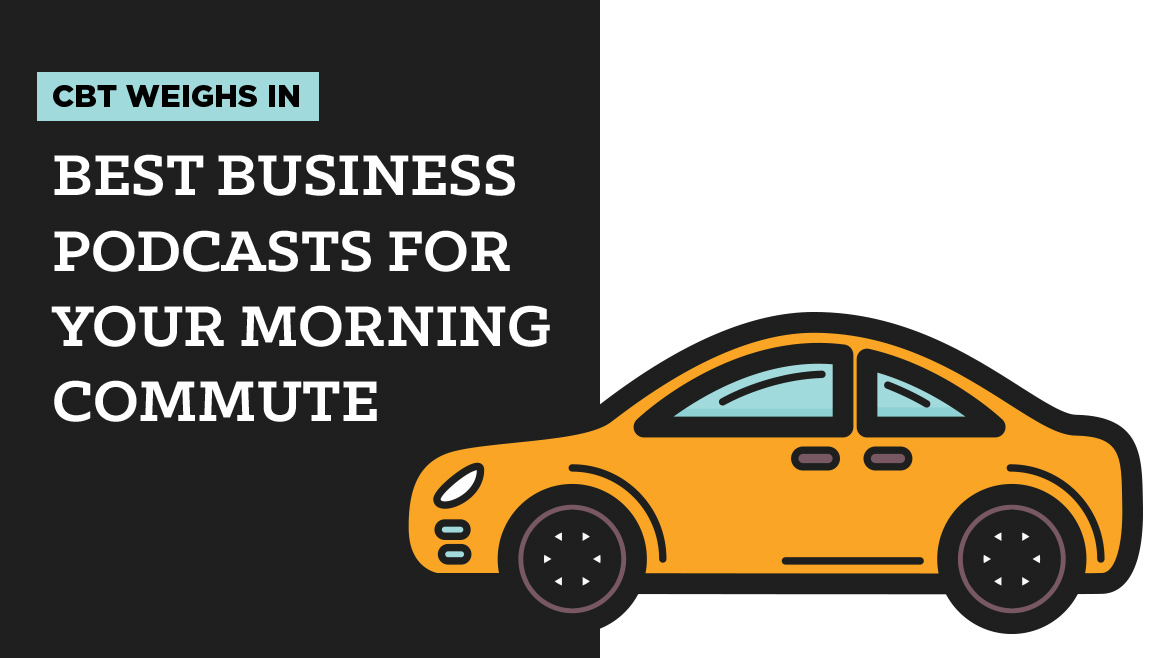
We’re big podcast fans over here at CBT, and we think there’s probably no better time to stimulate your brain than on your commute. We asked around the office and curated these three podcast picks that can help you and your business
“How I Built This” from NPR
This show brings on innovators and entrepreneurs to deconstruct their business strategies. Whether you’re just starting out on a project and looking for step-by-step advice or you’re an established leader looking to grow your company, you’ll get something out of these stories
“The Introvert Entrepreneur”
There’s a myth out there that startup leaders have to be charismatic extroverts. Phooey. Even if you’re not an introvert, this podcast will give you some insight to help you develop your business relationships more effective
“Creative Pep Talk”
Hosted by commercial illustrator Andy J. Miller, this podcast will teach you how to preach the value of creativity. Miller’s reflections dissect the highs and lows of the creative process — they’ll inspire you without feeling overwhelming. Just be sure to keep your hands on the wheel and save the note taking for the office.
When you have to commute every day, you get really, really good at making the drive seem painless — sometimes, it might even be fun. We got nosy with two Columbia businesspeople and asked about their commutes.
David Wallace
Director of Sales, Candlewood Suites
Where do you commute from? How long is the drive?
The west side of Jefferson City, Monday through Friday. It’s a 36 mile drive and takes about 30 minutes — Highway 50 to 54 to 63.
What’s your biggest pet peeve on the road?
You don’t have enough space for me to list them all, but all stupid drivers: People in the left lane doing less than the speed limit; people with no knowledge of what directional signals are for; distracted drivers on cell phones, doing their makeup, or doing anything but driving; bumper riders; people that speed up when you go to pass them; road ragers; semis that pass people; etc., etc., etc. I even bought a dash cam to record some of these idiots!
What do you do to pass the time?
Easy Listening Jazz on KJLU, a hot cup of coffee, and cruise control. It’s a good time to say my prayers for the day too.
What’s your favorite shortcut?
No good shortcuts between COMO and JC!
Any advice?
It appears that the police around Ashland and the highway patrol have a real problem with people from Columbia. In over two years of daily commutes, I’d say 99 percent of traffic stops I’ve seen happen to the Columbia-commuters’ side of Highway 63, so Columbia people beware!
Kevin Palmer
Chief Operating Officer, Columbia College
Where do you commute from? How long is the drive?
St. Peters, Missouri. It’s anywhere from one hour and 15 minutes to an hour and a half, depending on traffic and the location of Missouri State Troopers.
What’s your biggest pet peeve on the road?
Generally, slow driving in the fast lane — then speeding up when someone tries to pass you on the right. Ugh. Just move over! But in the past few years, my major pet peeve is seeing others texting, which is absolutely the worst driving habit.
What do you do to pass the time?
Audiobooks are great and better than satellite radio. I’ll also use the hands-free feature to make phone calls.
What’s your favorite shortcut?
No shortcuts — the drive is 97 miles on I-70. Columbia College and my house are both a half-mile off the highway.
Any advice?
Remember why you’re making the commute. I love my wife, Linda, and I love working at Columbia College and interacting with the wonderful people here. My wife doesn’t want to relocate from the house where we raised our children, and I’ve never worked at a better place with a better mission. When I worked in downtown St. Louis, it was a white-knuckle 50-minute commute, whereas the commute to Columbia is a relaxing 75 minutes. It gives me time to think through issues and harmonize my work life and private life.



